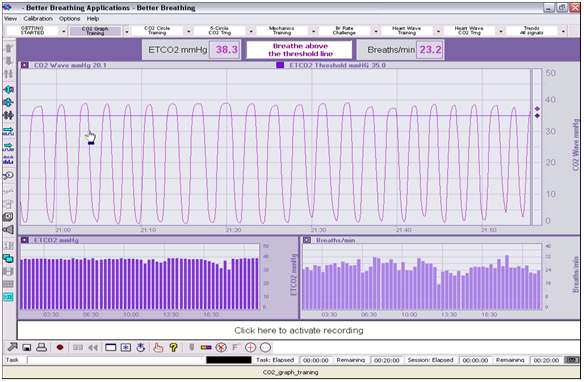Let Your Body Teach You How to Breathe Optimally Using Biofeedback
CapnoTrainer® Biofeedback Technology
Capnometry is the science of measuring partial pressure of carbon dioxide, CO2 (PCO2), during respiration. This is not new technology. It has been used extensively in hospital operating theatres and ICU’s. Because of the vital role of CO2 in respiration (see The Bohr Effect) and in blood chemistry (especially maintenance of correct blood pH), it is a medical necessity to monitor CO2 to ensure that they remain are in the correct ranges for maintenance of ideal functioning of the body. The CapnoTrainer® is a small and highly portable capnometer that, via software provides real time information on breathing efficiency.
The CapnoTrainer® provides for a continuous measurement of PCO2 while breathing. As there is only 0.03% CO2 in atmospheric air we breathe it reads effectively “zero” on inhalation. During the exhalation it rises sharply to the average level of PCO2 in the alveoli of the lungs, rising very slowly during the transition from exhale to inhale (alveolar plateau), and eventually reaching a peak immediately prior to the next inhale. This peak is known as the End Tidal carbon dioxide (ETCO2). The waveform is represented via a live graph on a computer screen is known as a Capnogram. See below.

ETCO2 in people with healthy lungs and a healthy cardiovascular system is highly correlated with the arterial partial pressure CO2 (PaCO2).
As previously mentioned The Bohr Effect states: “the lower the partial pressure of CO in arterial blood, the tighter the bond (or the greater the affinity) between haemoglobin and oxygen”. So PaCO2 is the limiting factor in breathing efficiency. It will determine how efficiently the oxygen we breathe is released from our blood to our cells for energy production. The minimal PaCO2 required for optimal respiration and release of O2 into cellular tissue for energy production is 40mmHg.
ETCO2 measurements on the CapnoTrainer will give an immediate look at the efficiency of an individual’s breathing based on the principles of The Bohr Effect. Less than optimal efficiency of breathing can lead to a multitude of symptoms as a result of the body’s need to compensate for this reduced functioning. These compensations include hypoxia (reduced oxygen supply) in cellular tissue, constriction or spasm in smooth muscle and excessive mucous production. And apnoea.
Respiratory rate is also obtained through measurement of the time between the end tidal peaks (diagnostic norms for breathing rate at rest are 8-10 breaths per minute). The averages of both respiratory rate and ETCO2 are plotted on a history graph for real time review.
The CapnoTrainer® provides immediate and first hand biofeedback information to the observer about air flow and breathing efficiency. Gasping and other breathing irregularities can immediately be seen.
Not only does the CapnoTrainer® measure breathing efficiency potentially in a variety of situations or circumstances (due to its great portability), it is also a fantastic tool to train an individual to improve their breathing efficiency. The CapnoTrainer® software offers a number of training tools to improve breathing efficiency. It can also be used as a measurement to verify the effectiveness of training interventions being performed by an experienced breathing practitioner or trainer.
CapnoTraining® can be used to improve breathing efficiency to treat a number of ailments, as a preventative measure to prevent anxiety, asthma, snoring etc. or as a means of enhancing performance with athletes, artists and business professionals.
I have used Capnometry to assess and retrain breathing for many years and find it an essential and fantastic means of retraining client’s breathing to alleviate symptoms and ailments, and to perform at greater levels.
It simple, quick and mobile. Contact me if you like to investigate further.


